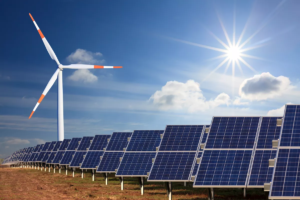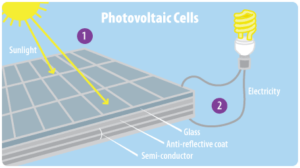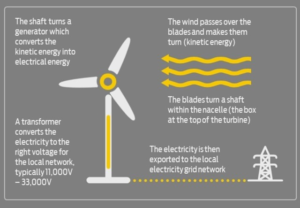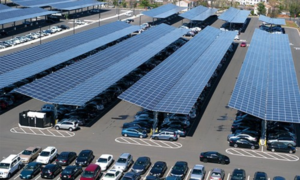Here is the Position Paper Article where I took a position to write this paper.

STOP using Fossil Fuels! Start using SOLAR ENERGY.
The United States and many other countries are wasting funds, on using fossil fuels and fracking by increasing the rate of global warming, when we can produce energy from the most abundant natural resource, the sun. The sun is the star at the center of the solar system and provides us with a massive amount of solar energy. Solar energy is an alternative renewable energy that can be used as long as the sun exists. But, in the places where we receive less sunlight, we can use Wind turbines to generate more energy. Wind power is a naturally abundant resource. Both resources decrease the level of Carbon emission in the atmosphere and reduce greenhouse gases.
The largest amount of energy comes from non-renewable resources such as fossil fuels, while another energy comes from renewable resources such as solar energy, wind power, hydropower, geothermal, Hydrogen etc. Renewable resources are unlimited, and they benefit our environment by reducing global warming and pollution. Although, there is concern about landmass, and expenses, a solution for this is improving the engineering process. The expense of both wind and solar energy alternatives can better, polluted area. Acknowledging the issue and keep individuals aware of these solutions is vital. On the other hand, non-renewable energy such as fossil fuels are limited, and it contributes to global warming, and if we continue to use the process of fracking and fossil fuels, it will continue to harm our earth extremely. The greenhouse will be affected, sea levels will continue to rise, and the rate of pollution will increase. The overall solution to this problem can be resolved through the most preeminent renewable-resource solar energy because it reduces carbon footprint and the greenhouse gases around the world. Also, we can combine solar power with the wind turbine for an area to produce more energy, where less sunlight is being reached because wind turbines do not pollute the air and do not produce atmospheric emission.
Solar energy is a radiant energy produced by the sun. Every day the sun radiates the massive amount of energy that can be utilized either directly as a heat or indirectly to convert into electrical power by using photovoltaic cells or steam-turbine plants (Alternative energy sources. 2011). Photovoltaic cells are made of solid substances, such as silicon that directly convert the light into electricity. It is known as “photoelectric effect that causes them to absorb photons of light and release electrons. When these free electrons are captured, an electron current results that can be used as electricity” (Knier 2008). These photovoltaic can be used to produce electricity as long as the sun continues to radiate energy. As the picture below shows:

Figure 1: The sun radiates energy and the photo-voltaic cell capturing the sunlight and converting them into electricity.
Wind power is a power that we gain by controlling the energy of wind using wind turbines. It is caused by “the uneven heating of the earth’s surface by the sun” (Alternative energy sources.2011). Which indicates that the earth’s surface in one area has higher pressures and another area has lower pressures because the sunlight is reaching unevenly in different places. To stabilize pressures, the earth needs wind to ensure equilibrium. It is considered an indirect solar power. Wind turbines extract energy by making the rotor spin, and the movement of the blades drives a generator that creates electricity. The motion of the wind turbines turning it into kinetic energy, which converts into electricity. As below pictures shows:

Figure 2: Wind turbines shaft turns converts the kinetic energy into electricity.
Both the wind turbines and solar panels do not produce greenhouse gases and decrease the rate of global warming. They benefit our environment, but there are concerns about the expenses and the ecosystem. Howard C. Hayden argues that “solar energy is too expensive and difficult to produce in quantities necessary to power world” (Hayden 2004). To implant solar panels, it costs a lot of money and it is not as cheap as fossil fuels. However, it is not about the cost, we are scared to invest money in solar power. When we didn’t even try to produce enough energy from the sun, then how would we know it wouldn’t generate the necessary power for the world. If we look at other parts of the world “through 2015, Germany alone had spent over $66 billion to support the deployment of solar power [ …]. More directly, the Chinese government lavished financial support for silicon solar produced by local industry. From 2010 to 2011 alone, the China Development Bank extended $47 billion in lines credit…” (Sivaram 2017). China and Germany have used solar energy for such a long time and they have been invested a lot of money. While the United States waited until online casinos 2015 “to extend its 30% solar tax credit through 2021, at a project cost of nearly $10 billion” (Sivaram 2017). Also, materials such as silicones are used for photovoltaic cells, they are not expensive. “From 1978 to 2015, the real cost of a solar panel declined from $80 per watt to below $0.50 per water around a 24% drop in cost for every doubling of cumulative production” (Sivaram 2017). Over the decades the price of photovoltaics cell decreased and if we continue to use it, the price will decrease more. Also, Henderson said “researchers at the University of Kansa… broke the all-carbon PV efficiency world record with a 1.3% efficient solar cell built from nanocarbons, materials that could help drastically reduce the cost of PV technologies in the future” (Kindscher 2014). Better materials but more efficiency will decrease the prices.
Furthermore, Wind power is one of the cheapest renewable-resources. “In 2013, the cost of generating a one-kilowatt hour of wind power was said to be about four cents, as compared to five cents for hydropower and fifteen cents for nuclear power. The costs are very cheap for wind power compares to other renewable energy. Also, from 1999 to 2013, an average wind turbines output increased by roughly 260%…” (Sivaram 2017). The rate of using wind power is increasing, Globally the wind capacity increased from 17.4GW in 2000 to 59.1 GW in 2005 to 282.4 GW in 2012” (Alternative energy sources.2011). As well as, in the future, the wind power will continue to produce more power. Therefore, solar panels and wind turbines have the potential to produce energy for the world as long as the industries and government invest money to improve the system.
Besides, many people are worried about the landmass because solar panels tales a lot of spaces. Howard C. Hayden argues in the United States, there are two major installations sites are producing minimum energy 10 MWe, when taking too 52.6 hectares from the environment. “Its capacity factor is about 16%. For Sola-Two installation to produce as much as a typical 1000-MWe power plant does in a year, it would have to cover about 33,000 hectares” (Hayden 2008). To decrease the amounts of land using, we can move the ecosystem from the places where we will install large solar sites and implanting panels in the rooftop. There are two types of rooftops, they are fixed and tracking. Fixed panels are directly exposed to the sun to generate energy while tracking panels have a motor to move in the directions of the sun to produce energy. Many schools, college, and university are producing electricity by installing solar panels in the campus. A solar installation company named Solar Liberty out of New York had several successful solar projects in the northeast of the United States. Most of their installation was in the education sector; one of their “successful installation was the St. Joseph’s Collegiate Institute, a small, private school in Buffalo, New York” (Kindscher 2014). According to Solar Liberty, “this system has 108 panels. Their panels generate an average of 26,448 kWh a year, which translated to over $3000 a year in saving…Every year the school alone decreases their CO2 emissions by 18.2 tons” (Kindscher 2014). These projects not only provide this school with electricity, but it also helps to save money, reduces 18.2 tons of CO2 going to the atmosphere and save the ecosystem. At the same time, students are learning about the importance of solar energy.
In addition, to save the ecosystem, we can install small solar panels in the street light and architectural solar canopies. Architectural solar canopies have the ability to change the pitched roof in two directions at the time of installation, “allowing for optimized solar absorption…Tracking solar canopies use motors to keep the panels at an optimum angle with the sun” (Kindscher 2014). Solar canopies provide up to 25% more energy. Therefore, solar energy can be produced anywhere as long as the sun exists.


Figure 3: Solar Canopies in the parking and solar panels installed in the street light.
In conclusion, solar power is one of the most efficient renewable energy. Form solar panels electricity can be produced as long as the sun is up in the sky. The solar power reduces the carbon dioxide emissions and do not pollutes the air or water like fossil fuels and fracking does. Also, combining with wind power makes it more powerful to supply electricity in an area where less sunlight is being reached. Both Solar power and wind power gives our earth time to get rides of toxic gases such as Carbon Dioxide and natural gases and to be green again. Also, they help to reduce air pollutions and water pollutions. So, we can inhale fresh breath, instead of toxic and fish in the water will get the chance to reproduce instead of getting extinct. Therefore, The United States and all countries must use solar energy and wind power to produce electricity, also by educating students in school and colleges that fossil fuels would not last forever, but the sun will.
References
“Alternative energy sources.” Environmental Encyclopedia, edited by Deridre S. Blanchfield, Gale, 2011. Opposing Viewpoints in Context, http://link.galegroup.com
Kiner, Gil. 2008. How do Photovoltaics work? https://science.nasa.gov/science-news/science-at-nasa/2002/solarcells
Kindscher, Dr. Kelly et all. 2014. A Solar Energy Proposal for the University of Kansas. https://sustain.ku.edu/sites/sustain.ku.edu/files/docs/Solar.pdf
Sivaram, Varun. 2017. Unlocking Clean Energy. Issues in Science and Technology. https://issues.org/unlocking-clean-energy/
Howard C. Hayden. 2004. The Solar Fraud: Why Solar Energy Won’t Run te World, Pueblo West, CO: Vales Lake publishing, LLC.pp.187-207. https://go.galegroup.com/ps/retrieve.do?tabID=Viewpoints&resultListType=RESULT_LIST&searchResultsType=MultiTab&searchType=BasicSearchForm¤tPosition=3&docId=GALE%7CEJ3010139274&docType=Viewpoint+essay&sort=Relevance&contentSegment=&prodId=OVIC&contentSet=GALE%7CEJ3010139274&searchId=R1&userGroupName=cuny_ccny&inPS=true


